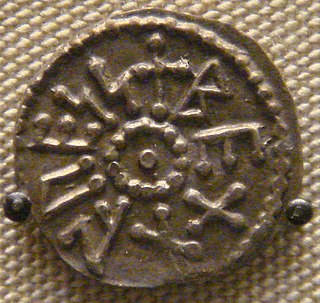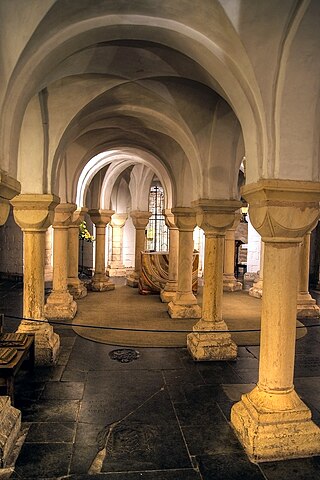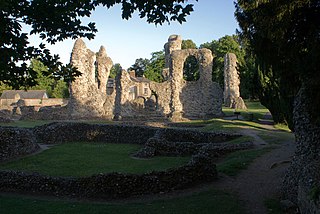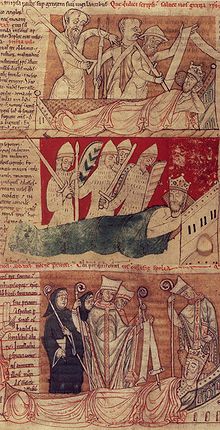Æthelweard was an ealdorman and the author of a Latin version of the Anglo-Saxon Chronicle known as the Chronicon Æthelweardi. He was a kinsman of the royal family, being a descendant of the Anglo-Saxon King Æthelred I of Wessex, the elder brother of Alfred the Great.
Florence of Worcester was a monk of Worcester, who played some part in the production of the Chronicon ex chronicis, a Latin world chronicle which begins with the creation and ends in 1140.
Thomas Walsingham was an English chronicler, and is the source of much of the knowledge of the reigns of Richard II, Henry IV, Henry V and the latter reign of Edward III depicting the decline of the state of affairs of the English. He also documented the careers of John Wycliff and Wat Tyler.

Eadmer or Edmer was an English historian, theologian, and ecclesiastic. He is known for being a contemporary biographer of his archbishop and companion, Saint Anselm, in his Vita Anselmi, and for his Historia novorum in Anglia, which presents the public face of Anselm. Eadmer's history is written to support the primacy of Canterbury over York, a central concern for Anselm.
Benjamin Thorpe was an English scholar of Anglo-Saxon literature.
Historians in England during the Middle Ages helped to lay the groundwork for modern historical historiography, providing vital accounts of the early history of England, Wales and Normandy, its cultures, and revelations about the historians themselves.

This article presents lists of the literary events and publications in the 12th century.

Beonna was King of East Anglia from 749. He is notable for being the first East Anglian king whose coinage included both the ruler's name and his title. The end-date of Beonna's reign is not known, but may have been around 760. It is thought that he shared the kingdom with another ruler called Alberht and possibly with a third man, named Hun. Not all experts agree with these regnal dates, or the nature of his kingship: it has been suggested that he may have ruled alone from around 758.
Pehthelm was the first historical bishop of the episcopal see of Candida Casa at Whithorn. He was consecrated in 730 or 731 and served until his demise. His name is also spelled as Pecthelm, Pechthelm, and sometimes as Wehthelm.
Ælfgifu of York was the first wife of Æthelred the Unready, King of the English; as such, she was Queen of the English from their marriage in the 980s until her death in 1002. They had many children together, including Edmund Ironside. It is most probable that Ælfgifu was a daughter of Thored, Earl of southern Northumbria and his wife, Hilda.
The Historia Regum is a historical compilation attributed to Symeon of Durham, which presents material going from the death of Bede until 1129. It survives only in one manuscript compiled in Yorkshire in the mid-to-late 12th century, though the material is earlier. It is an often-used source for medieval English and Northumbrian history. The first five sections are now attributed to Byrhtferth of Ramsey.
Siward Barn was an 11th-century English thegn and landowner-warrior. He appears in the extant sources in the period following the Norman Conquest of England, joining the northern resistance to William the Conqueror by the end of the 1060s. Siward's resistance continued until his capture on the Isle of Ely alongside Æthelwine, Bishop of Durham, Earl Morcar, and Hereward as cited in the Anglo-Saxon Chronicle. Siward and his confiscated properties in central and northern England were mentioned in Domesday Book, and from this it is clear that he was one of the main antecessors of Henry de Ferrers, father of Robert de Ferrers, the first Earl of Derby.
John of Eversden or Everisden was an English chronicler.
Sir Osbern Pentecost was a Norman knight who followed Edward the Confessor to England upon Edward's return from exile in Normandy in 1041.

Máel Coluim was an eleventh-century magnate who seems to have been established as either King of Alba or King of Strathclyde. In 1055, Siward, Earl of Northumbria defeated Mac Bethad mac Findlaích, the reigning ruler of the Kingdom of Alba. As a result of this military success against the Scots, several sources assert that Siward established Máel Coluim as king. It is uncertain whether this concerned the kingship of Alba or the kingship of Strathclyde.
The Winchcombe Chronicle is a Latin chronicle of the town of Winchcombe from about 1140-1145.

Nicholas of Worcester was prior of the Benedictine priory of Worcester Cathedral from about 1115 until his death. He was born around the time of the Norman Conquest. It is not known who his parents were, but the twelfth-century historian William of Malmesbury wrote that he was "of exalted descent", and the historian Emma Mason argues that he was a son of King Harold Godwinson.

The Bury Chronicle, Bury St Edmunds Chronicle, or Chronicle of Bury St Edmunds is a medieval English chronicle compiled by John of Taxster and two other unknown Benedictine monks of Bury St Edmunds Abbey in the 13th and 14th centuries.







